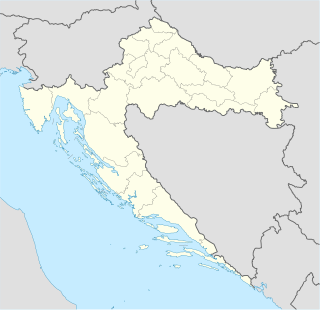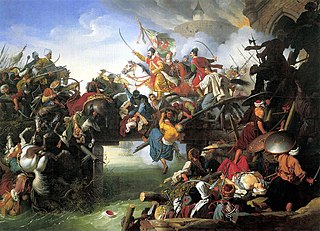| Emerik Derenčin Imre Derencsényi | |
|---|---|
| Ban of Croatia | |
| In office April 1493 –9 September 1493 | |
| Preceded by | Ladislav of Egervár |
| Succeeded by | Ladislaus Kanizsai |
| Personal details | |
| Spouse(s) | Ursula Zapolya |
| Parents | János Derencsényi |
| Military service | |
| Battles/wars | Battle of Krbava Field (1493) |
Emerik Derenčin (Hungarian : Imre Derencsényi, Croatian : Mirko Derenčin) was a Hungarian-Croatian nobleman remembered as the commander of the Croatian troops in the 1493 Battle of Krbava field.

Hungarian is a Finno-Ugric language spoken in Hungary and parts of several neighbouring countries. It is the official language of Hungary and one of the 24 official languages of the European Union. Outside Hungary it is also spoken by communities of Hungarians in the countries that today make up Slovakia, western Ukraine (Subcarpathia), central and western Romania (Transylvania), northern Serbia (Vojvodina), northern Croatia and northern Slovenia. It is also spoken by Hungarian diaspora communities worldwide, especially in North America and Israel. Like Finnish and Estonian, Hungarian belongs to the Uralic language family. With 13 million speakers, it is the family's largest member by number of speakers.

Croatian is the standardized variety of the Serbo-Croatian language used by Croats, principally in Croatia, Bosnia and Herzegovina, the Serbian province of Vojvodina, and other neighboring countries. It is the official and literary standard of Croatia and one of the official languages of the European Union. Croatian is also one of the official languages of Bosnia and Herzegovina and a recognized minority language in Serbia and neighboring countries.
He was a member of the Derencsényi family from the kindred of Balog. [1] Prior to becoming the ban, Derenčin was the military captain of Senj, [2] and the ban of Jajce. [3]

The Derencsényi was a Hungarian noble family from the 14th century to the end of the 16th century.
Ban was a noble title used in several states in Central and Southeastern Europe between the 7th century and the 20th century, primarily in medieval Croatia and Hungary and their respective predecessor states. In English, a common term for the province governed by the ban is banate and term for the office of the ban is banship.

Senj is an old town on the upper Adriatic coast in Croatia, in the foothills of the Mala Kapela and Velebit mountains.
Derencsényi and John Both were named the Ban of Croatia and Dalmatia and Ban of Slavonia in 1493. [4] In the Battle of Krbava field, the Croats under Derenčin suffered a devastating loss, and Derenčin himself was taken captive and killed.

Baron John Both de Bajna was a Hungarian nobleman from the Both family, who served as, alongside Emeric Derencsényi, Ban of Croatia, Slavonia and Dalmatia in 1493. His brother, Andrew Both also acted as ban from 1504 to 1507. Lord of Sykava in 1492, John was killed in the siege of Brinje in 1493.
Ban of Slavonia or the Ban of "Whole Slavonia" was the title of the governor of a territory part of the medieval Kingdom of Hungary and Kingdom of Croatia.












